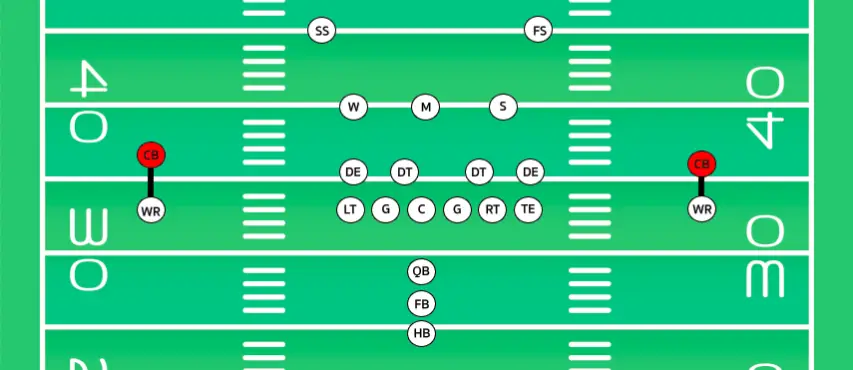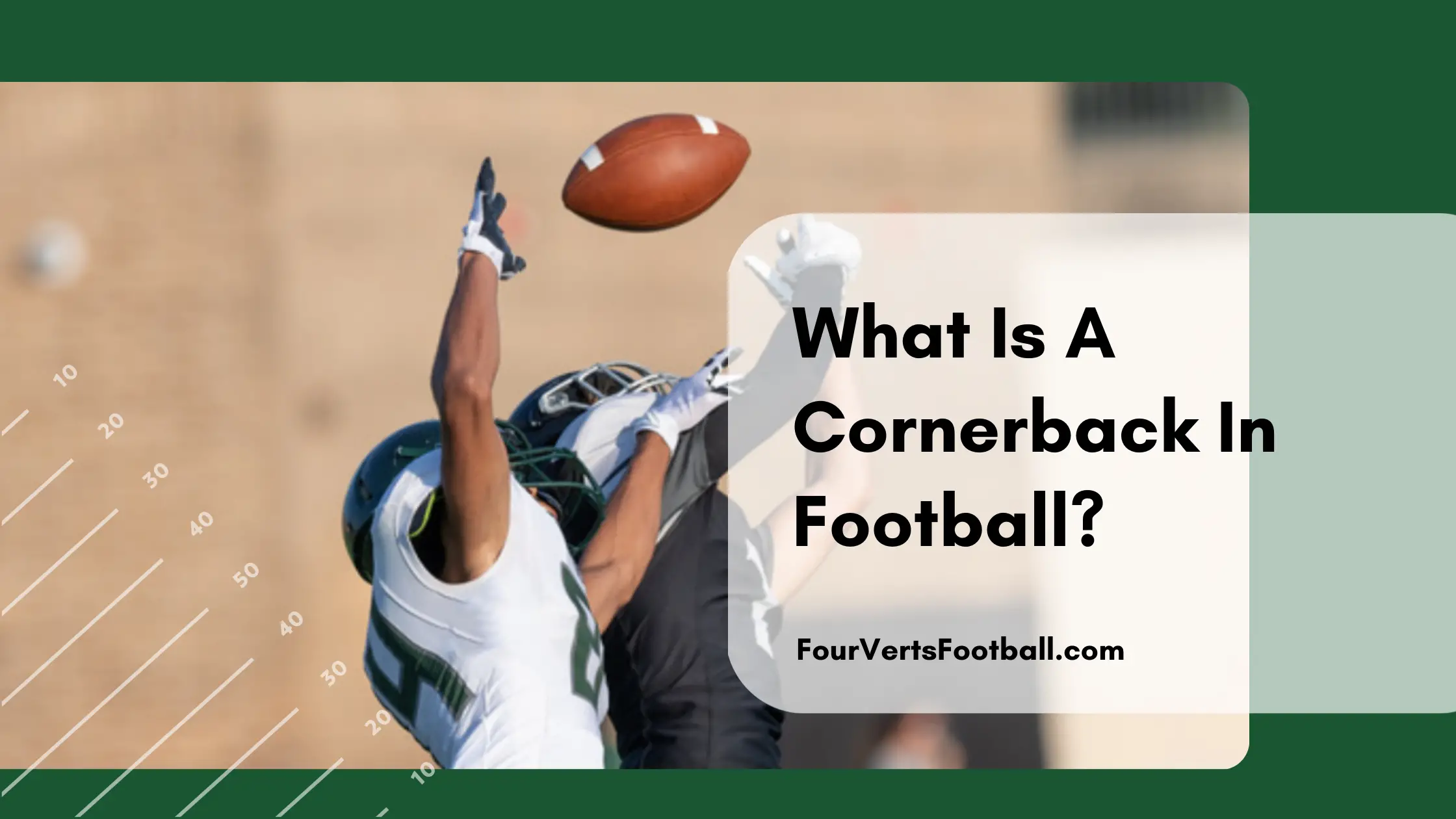Everyone knows who throws touchdowns in football but not many know the position responsible for stopping those passes.
A cornerback in football is a defensive position that is responsible for stopping the opposing team from completing forward passes. Cornerbacks spend most of their time covering wide receivers ensuring the opposing team’s quarterback is not able to throw to them.
Corners typically have a relatively small stature but make up for it with their speed and technique. This position also has responsibility in the run game but this is much less important than their ability to perform well in pass coverage.
This article is going to explain exactly what the cornerback position is in football as well as, break down what they do on a regular play.
What does a cornerback do?

As we stated earlier the main responsibility of a cornerback is to stop the opponent from successfully passing the ball.
To do this the cornerback is put into pass coverage. When in pass coverage the corner’s only focus on the play is that no pass be completed.
Pass coverage from corners is typically played in two common methods, man coverage and zone coverage.
Zone Coverage

Zone coverage in football refers to each player covering a specific area of the field. For example, let’s say the defense were playing a cover 3. In this situation, each cornerback is responsible for their deep third of the field.
This means their job is to protect this deep third and ensure anyone in it is covered. Zone coverage is very common in football and is an important skill to have as a cornerback.
Man To Man Coverage

The other form of coverage cornerbacks play is man-to-man. This coverage is exactly as what it sounds like.
The cornerback is assigned a specific offensive player to cover for the duration of the play. The cornerback must then follow this player around the field in order to ensure he doesn’t get open.
In many cases, the defense will play a combination of man and zone coverage.
This may mean the cornerback is in man coverage while a safety plays a deep zone.
When playing man-to-man cornerbacks will not always be in a 1 on 1 matchup. Other defensive players will often come to the cornerbacks aid, especially on deeper routes.
The defense does this because it can be quite difficult to cover wide receivers 1 on 1 at most levels of football.
Run Game Responsibilities.

Despite mainly being utilized for pass coverage purposes cornerbacks also have a hand in run defense.
Their actual assignments in the run game vary depending on the defense and personnel.
Though it is expected that cornerbacks are responsible for stopping the running back on rushes towards the sideline.
This is where the corner usually lines up putting him in the prime spot to make a tackle on outside runs.
Corners are not going to be a major piece of a run defense but they should be able to step up when necessary especially if a ball carrier is coming their way.
Since they are matched up against a wide receiver this is who they have to beat on running plays. When the opponents rush they are expecting their wide receivers to block the cornerbacks.
As a cornerback, it is their job to fight off these blocks and attempt to tackle the ball carrier.
Cornerback Attributes
There are many different attributes that go into being a successful corner but for time’s sake, we’ll cover the major ones. Those are speed, agility, and physicality.
Speed
Speed is one of the major factors in being a cornerback simply due to the speed of wide receivers.
It is no secret that wide receivers are usually considered the fastest position in the sport. Since cornerbacks are required to cover these players speed is a necessity.
That being said corners do not need to have the same level of speed as a receiver to cover him. As long as a corner has decent speed and utilizes their cushion well they should be able to keep up with receivers.
Agility
Agility in a cornerback is incredibly important in order to react to quick cuts by wide receivers. Another term often used to describe agility in corners is loose hips. Corners need to be able to rotate their hips quickly in order to match the route of the receiver.
This is an incredibly important aspect of pass coverage for a cornerback.
This is why teams will weigh three cone drills and other agility drills highly for a cornerback. If they are able to quickly move when in pass coverage they stand a better chance at defending NFL wide receivers.
Physicality
Physicality is another attribute we are going to cover in this guide. In physicality, we mean much more than just tackling. There are several aspects to playing cornerback that require the player to be physical.
First off is press coverage, when playing press the more physical you are the more successful you will be. This sort of physicality with receivers can be used throughout pass coverage as well, though it must be discreet in order to avoid a call.
Cornerbacks also need great physicality when it comes to breaking up passes. Oftentimes breaking up a pass is quite a physical process. This is especially true when multiple players are going for the airborne ball at once.
This makes the physical aspect of a cornerback important in terms of pass coverage and run defense.
Tackling
Though this position is not known for its tackling it is quite an important attribute. Not only are these players tasked with tackling the running back every once and a while they also must tackle wide receivers after catching the ball.
Poor tackling at the cornerback position can be deadly for a team. If players in the secondary miss a tackle it is much more likely to result in a touchdown.
Additionally, screenplays to wide receivers are quite common in football. On these plays, several receivers will attempt to block the cornerbacks in order to create room for the ball carrier.
If the cornerbacks fail to tackle the ball carrier they will likely get to the second level as the ball carrier will be close to the sideline and likely out of reach for the linebackers.
These sorts of plays require physical cornerbacks with good tackling ability. Failure to have this trait does not mean a cornerback will not succeed at the next level but it does mean he will not be able to fully master the position.
Build
The build of a cornerback is relatively flexible compared to other positions. The heights of prospects at the cornerback position is less of a concern than it is at others.
It can be helpful to have height at corner because this makes it easier to break up passes.
That being said many players that have the elite speed and agility required for cornerback do not have the height. This leaves leagues like the NFL having some players at the position measuring six feet two inches while others measure five foot seven.
The overall size of a cornerback should be quite small. These players need to stay light at this position in order to keep up with the wide receivers.
Though there are some responsibilities as a cornerback that is not a large part of the position. Putting on more weight in order to stop the run is not something that is often done by cornerbacks.
Positioning

On most plays, the cornerback is going to line up near the sideline with one on each side of the field. Typically a cornerback is going to be your right-most and left-most players in your defensive formation.
It is for these reasons that the cornerback is often responsible for sealing the edge and forcing the runner back inside on runs towards the sideline.
On most plays, the corner will either stay in their zone which is typically close to where they started the play. Or they will follow their wide receiver where ever he takes them on the field.
A variation of corner referred to as the slot corner plays in between the outside wide receiver and the formation. This cornerback is responsible for covering the slot receiver.
Concluding Thoughts
We hope you enjoyed this guide to understanding the cornerback position. If you have any more questions regarding this position in football please be sure to let us know and we’ll be happy to answer them for you.
Our guides on what a linebacker does and what a nickel corner does are other great resources to read.

